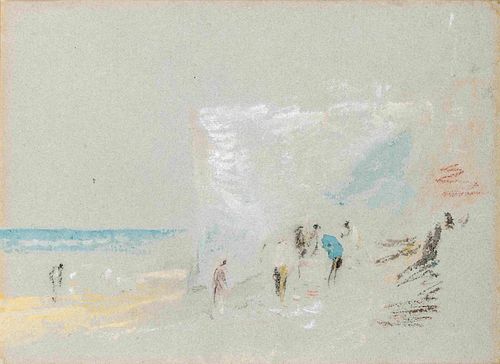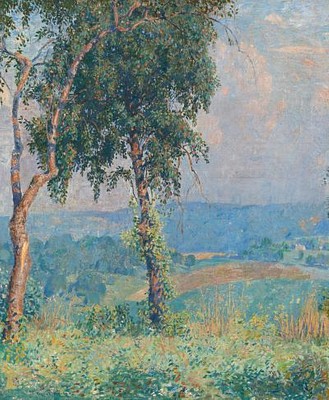Joseph Mallord William Turner(British, 1775-1851)Figures on the Cliffs at Margate, c. 1840-45
Lot 111
About Seller
Hindman
1338 West Lake Street
Chicago, IL 60607
United States
Recognized as the Midwest's leading fine art auctioneers, Hindman Auctioneers has built a worldwide reputation based on a full service approach to the auction business tailored to meet the individual needs of our clients. Coming from a variety of educational backgrounds, specialists bring years of e...Read more
Categories
Estimate:
$60,000 - $80,000
Absentee vs Live bid
Two ways to bid:
- Leave a max absentee bid and the platform will bid on your behalf up to your maximum bid during the live auction.
- Bid live during the auction and your bids will be submitted real-time to the auctioneer.
Bid Increments
| Price | Bid Increment |
|---|---|
| $0 | $25 |
| $500 | $50 |
| $1,000 | $100 |
| $2,000 | $250 |
| $5,000 | $500 |
| $10,000 | $1,000 |
| $20,000 | $2,500 |
| $50,000 | $5,000 |
| $100,000 | $10,000 |
About Auction
By Hindman
May 3, 2021
Set Reminder
2021-05-03 11:00:00
2021-05-03 11:00:00
America/New_York
Bidsquare
Bidsquare : American & European Art
https://www.bidsquare.com/auctions/hindman-auctions/american-european-art-6794
Hindman Bidsquare@hindmanauctions.com
Hindman Bidsquare@hindmanauctions.com
- Lot Description
Joseph Mallord William Turner
(British, 1775-1851)
Figures on the Cliffs at Margate, c. 1840-45
watercolor and chalk on gray paper
5 ¼ x 7 ¼ inches.
We would like to thank Ian Warrell for his help when cataloguing this lot.
Provenance:
Sophia Caroline Booth, the artist's landlady
Daniel John Pound, her son
Laurence W. Hodson, Compton Hall, by July 1884
Thence by descent
Sold: Sotheby's, London, November 30, 1978, Lot 97, part of A Volume of Watercolours, Chalk Drawings and Pencil Sketches (The Property of a Gentleman), probably identifiable as no. VI of the first group of sketches (Figures on Shore beneath Cliff)
Richard L. Feigen & Co., New York
Sold: Sotheby's, New York, October 29, 1987, Lot 28 (as Beach Scene with Figure)
Purchased directly from the above sale by the present owner
Exhibited:
Tokyo, Mitsukoshi Gallery, Turner Watercolours and Drawings, 1979-80, no.10 (caption refers to no. 7 in original sequence), illus.
New York, Castelli-Feigen-Corcoran Galleries, Turner: Watercolours and Drawings, March 3 - April 25, 1981Denver, Colorado, Gallery 609, J.M.W. Turner: Watercolours & Drawings, 1828-1850, 1981, no. 6 (as Cliffs with figures and sea)
Literature:Martin Butlin, J. M. W. Turner: Watercolours and Drawings, 1828-1850, Denver, 1981, no. 6 (as Cliffs with figures and sea)Ian Warrell, Turner's Sketchbooks, London, 2014, p. 213 (a related sketch)Jonny Yarker, €˜The Last Turner Sketchbook', online exhibition essay, May 21, 2020, https://www.libson-yarker.com/news-and-events/news/the-last-turner-sketchbook (discusses the notebook in which the present watercolor was originally included)
Property from a Private Collection, Taos, New Mexico
Lot essay:
This impressionistic scene was produced by Turner during the last decade of his life, when he was a regular guest of twice-widowed Sophia Caroline Booth at her lodgings on the Margate waterfront. The town lies downriver from London, beyond the Thames estuary, and close to the eastern-most edge of the Kent coast. Formerly a fishing port, it benefitted from the introduction of steamboats in the 1820s, which meant that it could be reached from the capital in less than a day, thereby helping to transform it into a seaside resort.
Mrs. Booth’s guest house was situated at the end of a row of houses that looked directly onto the sands of Cold Harbour, a little beach beyond the harbor walls, where in the mid-1820s a new wooden jetty was constructed to permit the steamboat passengers to disembark safely, even at low tide[1]. Rising steeply from the little promenade, the coastal path followed the cliffs up to the peak of Fort Point, which provided an uninterrupted panorama of the shore and busy shipping lanes in either direction.
Turner knew Margate as a child and returned often in later life because of the character of the light, which he claimed to be the ‘loveliest in Europe.’ Repeated stays at Mrs. Booth’s establishment resulted in a growing intimacy between them, although this was something that had to be concealed in the Victorian era. More prosaically, as a healthy younger woman, she was also able to take on some of the domestic and logistical tasks that had formerly been performed by his father, who died in 1829.
Turner’s health was increasingly fragile in the 1840s, as he entered his late sixties. But from Mrs. Booth’s windows he was able to survey the human activity of the foreshore, as well as the ever-changing cyclorama of light and cloud effects above the sea, without having to venture outside. As a result, he produced a significant body of sketches, watercolors, and oil paintings that in recent years has attracted new interest, as Turner made these for his own pleasure or reference, lending them the status of direct expressions of personal fascination or emotion.
After Turner’s death the contents of his London studio were the subject of a protracted legal tussle in the Court of Chancery but were eventually defined as the ‘Turner Bequest’ and placed in the National Gallery. Official ignorance of his connection with Mrs. Booth meant that the works left in her Margate house, and another home that she and Turner later shared on the banks of the Thames in Chelsea, were overlooked in the 1856 settlement. However, it was nearly a decade before Mrs. Booth’s son, Daniel Pound, started to sell these items, most of which dated from Turner’s final years.
The first documented owner of this view of the Margate cliffs was brewery owner Laurence Hodson (1864-1933), based at Wolverhampton in the industrial English Midlands, whose interest in Turner is typical of the newly wealthy mercantile collectors of the late nineteenth century. The album in which it came to auction at Sotheby’s in 1978 appears to have been created some time around July 1884 by Hodson through the process of what he described as breaking up and mounting two existing sketchbooks. The material in the album fell into three distinct types: 13 studies of shipping and beach scenes on a variety of different toned papers; 14 sketches made in Germany, often on white paper prepared with a gray wash; and 17 pencil drawings very obviously from a broken-up sketchbook used during a tour of Kent. Although it might seem logical to assume the last two categories constituted the two former sketchbooks, recent research suggests that the third of these three components, the studies made in Kent, seems likely to have been previously owned by an earlier collector. Frustratingly, Hodson did not specify in his notes where and when he acquired this third batch of sketches. Nevertheless, they can almost certainly be tracked back to Daniel Pound, who had also sold Hodson the two smaller groups.
The 13 coastal scenes are the most relevant to the Margate cliff subject here and span three different types of drawing paper, including blue, light buff, and light gray paper, on which the present work was executed. Each of these sheets measure roughly 5 ½ x 7 ½ inches, but they were originally part of much larger pieces of paper that Turner habitually folded into sixteen sections, enabling him to work his way steadily across, putting down rapid outlines of his observations. The paper historian Peter Bower has proposed that, although the gray paper would have been available to Turner as early as 1829, his most concentrated use of it appears to have been during the years around 1840.
The two studies on gray paper from the Hodson album can be related to others in the Turner Bequest (now at Tate Britain), and in other museums and private collections, evoking incidents witnessed at Margate. Perhaps the most closely related example is a watercolor sold recently at Christie’s, New York: Figures by the Shore at Margate (January 30, 2018, Lot 85). As in the present artwork of figures struggling up the cliff, Turner evolved the image through an economic combination of chalky stabs and rubbings, coupled with judiciously placed splashes of watercolor. Placed side by side, the two images combine effectively to reconstruct the view Turner had from the windows of Mrs. Booth’s lodging-house, showing the cliffs to the east and, in the opposite direction, beyond Jarvis’s Landing Place, towards Margate’s stone harbor walls and lighthouse. Everything is captured in motion, and these private snap shots vividly bring to life a setting that Turner evidently savored.
Ian Warrell
Independent Curator; currently Senior Visiting Scholar for Collections Research at the Yale Center for British Art, New Haven
[1] For more on the setting, see Ian Warrell, ‘From Cold Harbour, Margate, to the White House: New Light on One of Ruskin’s Turners’, Turner Society News, Spring 2019, vol.131, pp. 4-14.[2] See Peter Bower, Turner’s Later Papers. A Study of the Manufacture, Selection and Use of his Drawings Papers 1820-1851, exhibition catalogue, Tate Gallery 1999, pp.69, 88-93, 109.For condition inquiries please contact marygracebilby@hindmanauctions.comCondition
- Shipping Info
-
Please refer to https://hindmanauctions.com/shipping-packing
-
- Buyer's Premium



 EUR
EUR CAD
CAD AUD
AUD GBP
GBP MXN
MXN HKD
HKD CNY
CNY MYR
MYR SEK
SEK SGD
SGD CHF
CHF THB
THB














